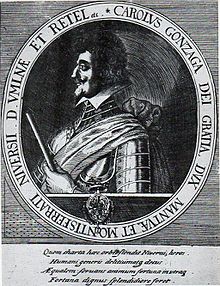Charles II Gonzaga, Duke of Nevers
Charles II Gonzaga, Duke of Nevers | |
|---|---|
 Portrait of Charles of Gonzaga-Nevers from Matthäus Merian's Theatrum Europaeum | |
| Born | 22 October 1609 |
| Died | 30 August 1631 (aged 21) Cavriana |
| Noble family | Gonzaga |
| Spouse(s) | |
| Issue | Maria Gonzaga Charles II, Duke of Mantua and Montferrat Eleonora, Holy Roman Empress |
| Father | Charles I, Duke of Mantua |
| Mother | Catherine de Lorraine-Guise-Mayenne |
Charles II Gonzaga (22 October 1609 – 30 August 1631) was the son of Charles I, Duke of Mantua,[1] and Catherine de Lorraine-Guise (also known as Catherine de Mayenne). He was the Duke of Nevers and Rethel, together with his father.
In 1621, he succeeded his uncle Henri de Lorraine-Guise as Duke of Mayenne. In 1627 he married his cousin Maria Gonzaga, Marquise of Montferrat and heiress to the Duchy of Mantua.[2] However, Cesare II Gonzaga, Duke of Guastalla and Emperor Ferdinand II rejected her claim to Mantua, leading to the War of Mantuan Succession (1628–1631).
Charles was never Duke of Mantua since he died at Cavriana six years before his father. When the latter died in 1637, Charles's eight-year-old son, Charles II, became Duke of Mantua, his widow Maria acting as regent. His daughter Eleonora became Holy Roman Empress.
Family
In December 1627 he married his cousin Maria Gonzaga, the marriage being arranged by Vincenzo II Gonzaga.
Charles and Maria had:
- Maria Gonzaga
- Charles II, Duke of Mantua and Montferrat (1629–1665).[3]
- Eleonora (1630–1686), who married in 1651 Ferdinand III, Holy Roman Emperor.[2]
References
- ^ Sanders 2012, p. 171.
- ^ a b Bourne 2016, p. 162.
- ^ Ward, Prothero & Leathes 1934, p. table 75.
Sources
- Bourne, Molly (2016). "From court to cloister and back again: Margherita Gonzaga, Caterina dé Medici and Lucrina Fetti at the convent of Sant'Orsola in Mantua". In Cavallo, Sandra; Evangelisti, Silvia (eds.). Domestic Institutional Interiors in Early Modern Europe. Routledge. p. 153-180.
- Sanders, Donald C. (2012). Music at the Gonzaga Court in Mantua. Lexington Books.
- Ward, A.W.; Prothero, G.W.; Leathes, Stanley, eds. (1934). The Cambridge Modern History. Vol. XIII. Cambridge University Press.
